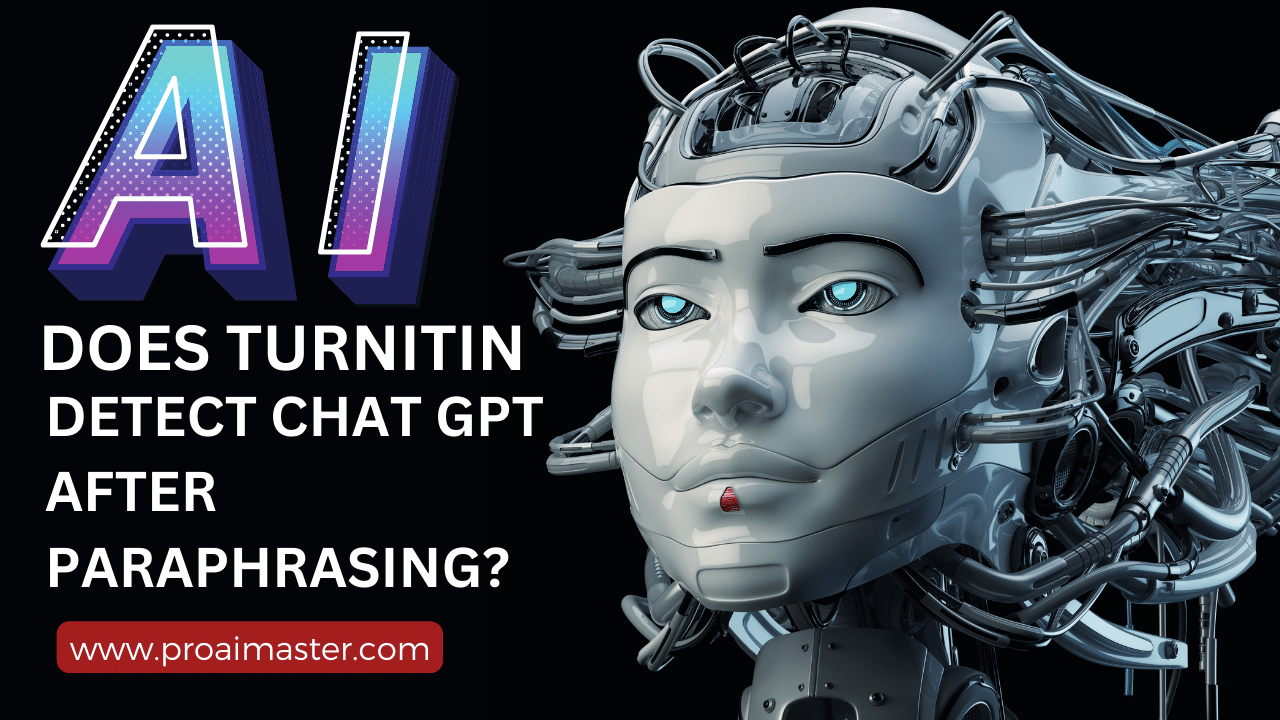As technology advances, so does the complexity of plagiarism detection software. Turnitin, a widely used plagiarism checker, has gained prominence in academic institutions for its ability to identify copied content.
However, with the emergence of advanced language models like Chat GPT, there arises a question: Can Turnitin effectively detect content generated by such AI models, even after it has been paraphrased?
In this article, we will delve into the capabilities of Turnitin in identifying AI-generated content and the challenges it may face when dealing with paraphrased text produced by models like Chat GPT.
Understanding Turnitin and Its Detection Mechanism

Turnitin is a popular plagiarism detection tool utilized by educational institutions to analyze submitted documents for potential instances of plagiarism. Its algorithm functions by comparing the submitted text with a vast database of academic content, including articles, essays, and other publications.
The detection mechanism employed by Turnitin involves various techniques such as string matching, fingerprinting, and natural language processing. It identifies similarities between the submitted text and existing content, highlighting potential instances of plagiarism for further review.
Introduction to Chat GPT and Its Paraphrasing Abilities
Chat GPT is an advanced language model developed by OpenAI, designed to generate human-like responses based on the provided input. It is trained on a massive dataset and can understand context, produce coherent sentences, and even paraphrase text.
Paraphrasing, a common technique employed to evade plagiarism detection, involves rephrasing existing content while maintaining the core meaning. Chat GPT is capable of paraphrasing text by comprehending the input and generating alternative wordings, making it challenging for plagiarism detection software to detect instances of copied content.
Turnitin’s Capabilities in Detecting AI-Generated Content
While Turnitin has been successful in identifying straightforward instances of plagiarism, its effectiveness in detecting AI-generated content has limitations. Turnitin’s algorithm is primarily based on pattern recognition and string matching, which may struggle to identify content that has been heavily paraphrased or generated by AI models like Chat GPT.
Turnitin’s database mainly consists of existing academic texts, research papers, and publications. Since Chat GPT produces unique content that is not present in its database, there is a higher likelihood that AI-generated content can go undetected.
Furthermore, since AI models like Chat GPT can paraphrase text effectively, it becomes even more challenging for Turnitin to flag potential instances of plagiarism accurately.
Challenges Faced by Turnitin in Detecting Paraphrased AI-Generated Content
- Vocabulary Variation: Chat GPT has a wide range of vocabulary at its disposal, allowing it to generate alternative word choices and sentence structures. This poses a challenge for Turnitin, as it relies on specific words and phrases to identify potential matches.
- Sentence Restructuring: Paraphrased content generated by AI models often involves reordering sentences and altering sentence structures, making it difficult for Turnitin to identify similarities based on sentence patterns.
- Synonym Substitution: AI models can replace words with synonyms while maintaining the overall meaning of the content. Turnitin’s string matching approach might fail to recognize such paraphrased content as it cannot detect the semantic similarity between the original and paraphrased text.
Potential Solutions and Future Developments
As technology advances, plagiarism detection software like Turnitin will need to adapt to identify AI-generated and paraphrased content more effectively. Some potential solutions include:
- Advanced AI Detection: Incorporating machine learning and natural language processing techniques to enhance the capability of plagiarism detection software in identifying AI-generated content.
- Contextual Analysis: Developing algorithms that consider the context and meaning of the text rather than relying solely on string matching. This could involve analyzing sentence structures, semantic relationships, and overall coherence.
- Collaboration with AI Developers: Collaboration between plagiarism detection software providers and AI developers can lead to the development of more sophisticated algorithms that account for the advancements in AI technology.
Limitations of Turnitin’s Database
Turnitin’s effectiveness in detecting AI-generated content is also influenced by the content available in its database. While it contains a vast collection of academic texts, research papers, and publications, it may not include a comprehensive representation of AI-generated content.
This limitation can hinder Turnitin’s ability to accurately detect paraphrased text or content produced by AI models like Chat GPT.
Evolving AI Models and Countermeasures
As AI models continue to advance, they may become more adept at evading plagiarism detection. Developers can create AI models specifically designed to circumvent detection mechanisms by mimicking human writing styles, incorporating subtle variations, or utilizing advanced paraphrasing techniques.
This constant evolution poses a challenge for Turnitin and similar software to keep up with the ever-changing landscape of AI-generated content.
Manual Review and Human Expertise
While plagiarism detection software like Turnitin plays a crucial role in identifying potential instances of plagiarism, it should not be solely relied upon.
Manual review by educators and subject matter experts remains a valuable aspect of the plagiarism detection process. Human expertise can detect nuances, understand the context, and identify content that may have evaded the detection capabilities of the software.
Educational Strategies and Academic Integrity
The emergence of AI-generated content highlights the need for educational institutions to emphasize academic integrity and educate students about the ethical use of AI tools.
By promoting critical thinking skills, proper citation practices, and originality, institutions can foster an environment that discourages plagiarism and encourages responsible use of AI technologies.
Future Developments in Plagiarism Detection
Recognizing the challenges posed by AI-generated content, researchers and developers are actively working on improving plagiarism detection systems.
This includes the exploration of new algorithms, the incorporation of AI and machine learning techniques, and the development of comprehensive databases that encompass a wider range of AI-generated content.
Future developments aim to enhance the accuracy and effectiveness of plagiarism detection software in identifying paraphrased AI-generated content.
Conclusion
Turnitin, while effective in identifying blatant instances of plagiarism, faces challenges when it comes to detecting AI-generated content, especially after paraphrasing. The advanced capabilities of AI models like Chat GPT, including paraphrasing abilities, present difficulties for Turnitin’s traditional detection mechanisms.
To address these challenges, it is essential for plagiarism detection software to evolve and incorporate advanced AI detection techniques and contextual analysis. As the technology progresses, collaboration between software providers and AI developers will be crucial in developing more effective solutions for identifying AI-generated content.
FAQs
Can Turnitin detect AI-generated content even if it has been translated into another language?
Turnitin primarily relies on the similarity between submitted text and existing content in its database. If the AI-generated content has been translated into another language, it may reduce the chances of detection since the database may not contain the translated version of the content. However, it’s important to note that Turnitin supports multiple languages, and it can still flag instances of plagiarism if the translated content matches existing content in its database.
Are there any other plagiarism detection tools that are better at identifying AI-generated content?
While Turnitin is a widely used plagiarism detection tool, there are other software options available in the market that claim to have enhanced capabilities in identifying AI-generated content. These tools often employ more advanced algorithms, machine learning techniques, and larger databases to detect instances of plagiarism, even when it involves AI-generated or paraphrased content. It is advisable to explore different options and consult experts in the field to choose the most suitable tool for specific needs.
Can Turnitin detect if AI-generated content has been paraphrased by a human?
Turnitin’s detection mechanism is primarily focused on identifying similarities between submitted text and existing content. It can potentially detect instances where human-generated content has been paraphrased from existing sources.
Is it ethical to use AI-generated content without proper attribution?
Using AI-generated content without proper attribution can be considered unethical and a violation of academic integrity. While AI models like Chat GPT can generate human-like responses, it is essential to acknowledge the source and provide appropriate citations when utilizing AI-generated content in scholarly work.

Muhammad Ahmad is a dedicated writer with 5+ years of experience delivering engaging and impactful content. He specializes in simplifying complex topics into easy-to-read articles.


